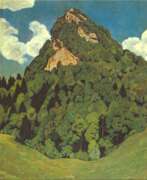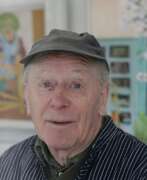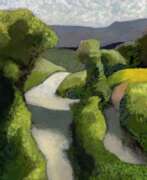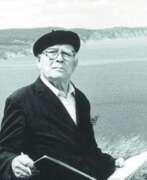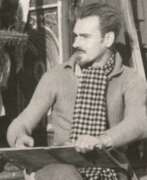Wood carvers 20th century


Ivan Mikhailovich Abalyaev (Russian: Иван Михайлович Абаляев) was a Russian artist, recognized for his influential role in the Leningrad School of Painting. Born into a peasant family in 1924, Abalyaev's artistic journey began at the Leningrad Institute of Painting, Sculpture, and Architecture. His art, characterized by a profound connection to Russian rural life and landscapes, captures the essence of his early life experiences in Nizhnyaya Loshikha, Smolensk region.
Abalyaev's works are renowned for their vivid portrayal of the Russian countryside, often reflecting the serene and laborious life of its inhabitants. His mastery in landscape painting earned him significant recognition, including the prestigious title of People's Artist of the Russian Federation. Throughout his career, Abalyaev remained dedicated to exploring and expressing the natural beauty and the cultural depth of rural Russia, contributing significantly to the cultural heritage of his country.
For those interested in the evocative landscapes and cultural narratives captured by Ivan Mikhailovich Abalyaev, his works are valuable collectibles and are often featured in art galleries and auctions. To stay updated on new discoveries of his works and upcoming auction events featuring Abalyaev, signing up for updates is highly recommended. This will ensure that collectors and art enthusiasts don't miss out on the opportunity to own a piece of Russian art history.


Karel Brož (Russian: Карл Осипович Брож) was a Czech and Russian artist, renowned for his detailed illustrations and watercolors. Born on November 25, 1836, in Prague, he studied at the Vienna Academy of Fine Arts and later moved to Russia, where he became a prominent illustrator for various publications, including "Vsemirnaya Illustratsiya."
Brož's work is characterized by its meticulous attention to detail and vibrant depictions of historical and everyday scenes. His illustrations, particularly for Russian periodicals, captured the essence of 19th-century life and remain highly regarded in art circles.
Collectors value Brož's pieces for their historical significance and artistic quality. His illustrations have been featured in numerous exhibitions and are part of prestigious collections. For those interested in historical illustrations, Karel Brož’s work offers a unique glimpse into the past.
Sign up for updates on new product sales and auction events related to Karel Brož to stay informed about the latest opportunities to acquire his work.
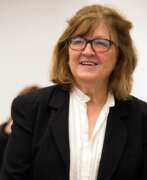

Vija Celmins is a Latvian-American artist. She is best known for her photorealistic paintings and drawings of natural and man-made objects.
Celmins and her family fled Latvia during World War II and eventually settled in the United States. She studied art at the John Herron School of Art in Indianapolis and later at the University of California, Los Angeles.
Celmins began her career as a painter in the 1960s, and by the 1970s she had developed her signature style of photorealism. She is known for her painstaking attention to detail, and her paintings and drawings often take months or even years to complete. Some of her most famous works include images of the night sky, oceans, and rocks.
Celmins has been the subject of numerous solo exhibitions in museums and galleries around the world, including a retrospective at the Centre Pompidou in Paris in 2006. Her work is held in the collections of many major museums, including the Metropolitan Museum of Art in New York, the Museum of Modern Art in New York, and the National Gallery of Art in Washington, D.C.


Nikolai Ivanovich Fechin (Russian: Николай Иванович Фешин) was a Russian and American artist of the first half of the twentieth century. He is known as a painter, master of domestic and portrait genres, representative of Impressionism and Art Nouveau. Nikolai Fechin was also a graphic artist, sculptor, and carver, and at the initial stage of his professional career he showed himself as a teacher.
Nikolai Fechin spent a considerable part of his life in emigration, where he quickly managed to achieve recognition and commercial success. He created more than two thousand works, which are now scattered around the world. The largest collection of Fechin's works is in Russia in the Museum of Fine Arts of Tatarstan. And some of his works are in the collections of more than thirty museums in the United States, as well as in private collections.


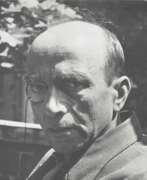

Paul Gangolf, real name Paul Löwy, was a German expressionist painter, lithographer, woodcarver and journalist.
Paul was born into a Jewish family, began his work with articles in magazines on political topics, using the pseudonym Gangolf, during the First World War he served in various troops.
The peak of Paul Gangolf's creative activity came in the 1920s, when he worked in lithography, published and exhibited in Berlin, London and Paris.
After the National Socialists came to power, he was arrested and taken to the Esterwegen concentration camp, where he was murdered. Already after his death, in 1937, as part of the "Degenerate Art" campaign, Gangolf's paintings were confiscated from museums in Nazi Germany and most were destroyed. Surviving works by the artist can be found at the Museum of Modern Art in New York and others.


Franz Gertsch is one of Switzerland's most outstanding contemporary artists. Throughout his career, he has produced a wide range of paintings and graphic works in which he tries to find a particular approach to reality. Although the author uses photographs or slide projections as his starting points, the paintings adhere to a logic of their own which seeks the correctness of all elements. Woodcuts also occupy a special place in Franz Gertsch's work.


Werner Gothein was a German painter, sculptor, printmaker and ceramicist-designer.
Gothein studied art in Berlin and mastered the techniques of painting, sculpture and wood engraving. In the 1920s, he began designing ceramic objects for the Karlsruhe State Maiolica Manufactory and the Felten-Vordamm ceramic factories.
In 1937, as part of the Nazi "Degenerate Art" campaign, Gothein's graphics were withdrawn from German museums and collections, most of them later destroyed. After the end of World War II, the artist continued to create woodcuts.


Kęstutis Grigaliūnas - Lithuanian graphic artist, art teacher. 1988-1989 created linen carvings, wood carvings, screen prints, etchings, illustrated books. Since 1990 one of the first Lithuanian graphic designers to use the color screen printing technique. Made a cut out of cardboard and plywood. It is characterized by a pronounced graphic beginning - lines, signs, ornaments, figurative and abstract motifs are used. Since 1998 creates more complex plastic graphic works and cut-outs, they feature postmodernism features, pop art, Fluxus elements, decorative, eclectic images. A playful mood, irony, and various intellectual references to the images of Lithuania and other cultures and civilizations prevail.


Walter Helbig is a German and Swiss painter, graphic designer and woodcarver. He works in Dresden on church paintings. Helbig participated in the founding and first exhibition of the "Neue Secession" in Berlin in 1910. Helbig took part in the first Modern Bund exhibition in 1911 in Lucerne and in the second, larger one, at the Kunsthaus in Zurich. In 1914, some painters from the vanished “Modern Bund”, including Helbig, took part in the first Dada exhibition at the Galerie Coray in Zurich. Helbig is also represented in the third Dada exhibition and contributes to the magazine Der Zeltweg 8 but does not participate in the activities of the Dadaists. In 1919, he was one of the signatories of the “manifesto of radical artists” 9 in Zurich, and joined the “November group” in Berlin. Helbig lived in Zurich from 1916 to 1924 and in 1916 became a member of the GSMBA (Society of Swiss Painters, Sculptors and Architects), in which he regularly participated. Since the First World War, his artistic work has turned to religious and mythical subjects. In 1924 Helbig, like many other artists, moved to Ascona due to the low cost of living and founded the movement Der Große Bär. During this time, Helbig painted landscapes, still lifes and portraits. Walter Helbig had his first major solo exhibition in Zurich in 1948 and became a member of the Association of German Artists in 1952. After the Second World War, he also followed the artistic currents of the time, abstract expressionism and experimented with informal art in the 1960s.


Vytautas Jurkūnas (Russian: Витаутас Юркунас) was a Lithuanian graphic artist, celebrated for his distinctive approach to printmaking and book illustration. Born in 1910 in Vindeikiai, he carved out a significant presence in the Lithuanian art scene from the interwar period through to the late 20th century, until his death in 1993 in Vilnius. Jurkūnas' education at the Kaunas School of Art laid the groundwork for a career that spanned teaching at the Vilnius Art Institute, where he influenced generations of artists, and exploring a wide array of graphic techniques, notably in linocut and wood engraving.
His early works, such as "Mother with Child" (1935) and the "Fishermen" series (1937-1939), showcase a unique style characterized by expressive lines, dynamic strokes, and a blend of realism with abstraction. During WWII, Jurkūnas produced compelling compositions reflecting the brutality of war, which added depth to his portfolio of socially and politically charged themes. Post-war, he gained renown for his book illustrations, employing linocut and wood engraving techniques to create images that resonated deeply with the textual narratives they accompanied. Notably, his illustrations for Kristijonas Donelaitis' "The Seasons" received significant acclaim.
Jurkūnas' contributions to Lithuanian graphic art are preserved in the collections of the National M. K. Čiurlionis Art Museum, the Lithuanian National Museum, and internationally, showcasing his enduring legacy. His work received the LSSR State Prize in 1957, marking a high point in his career and affirming his status as a pivotal figure in Lithuanian art.
For collectors and experts in art and antiques, Vytautas Jurkūnas' oeuvre offers a compelling study in the evolution of Lithuanian graphic art, with works that reflect the socio-political landscape of his time and his mastery of graphic techniques. To stay updated on exhibitions and auctions featuring Vytautas Jurkūnas' works, sign up for updates. These subscriptions provide insights into new sales and events dedicated to his legacy, offering a unique opportunity to engage with the rich history of Lithuanian art.
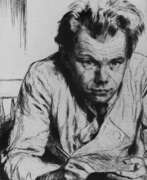

Hermann Kätelhön was a German artist of the first half of the twentieth century. He is known as a realist painter, graphic artist, woodcarver and ceramicist.
Kätelhön created works depicting the people and nature of middle Germany, including portraits of peasants and sketches of fieldwork scenes. His graphic series "Work" as well as his drawings on the theme "Mining Leaders" explore the labor of miners. The artist later turned to depicting nature, especially water, including springs, rivers, glaciers, and seas.




Sergey Timofeyevich Konenkov (Russian: Серге́й Тимофеевич Конёнков) was a Russian and Soviet sculptor, often hailed as "the Russian Rodin." Born into a peasant family in 1874 in the Smolensk region, he pursued his passion for art, studying at the Moscow School of Painting, Sculpture and Architecture, and later at the Academy of Arts. Konenkov's work was deeply influenced by his roots, leading to the creation of sculptures that blended Russian folklore with Hellenic and Russian culture.
Konenkov's career took a significant turn when he moved to the United States in 1923, where he stayed for 22 years. This period was marked by his exploration of biblical themes, creating renowned works that depicted Jesus Christ, Christian prophets, and apostles. His notable commission of a sculpture of Albert Einstein by Princeton University highlights his prominence during this period. Upon his return to the USSR under Stalin's directive, Konenkov continued his artistic endeavors, receiving numerous accolades including the golden star of the Hero of Socialist Labour and the order of Lenin.
His legacy includes a vast collection of works, with some of his most famous sculptures housed in the Tretyakov Gallery and the museum dedicated to his works in Smolensk, established posthumously in 1970. The museum's foundation was laid with forty of his creations, showcasing his significant contribution to Russian and Soviet art.
For collectors and experts in art and antiques, Konenkov's sculptures represent a unique fusion of cultural narratives and a testament to his innovative approach to sculpture. His works continue to be celebrated for their depth, creativity, and influence on the art world.
To stay updated on sales and auction events related to Sergey Timofeyevich Konenkov's work, sign up for updates. This subscription ensures you're informed about the latest opportunities to own a piece of Russian and Soviet art history.
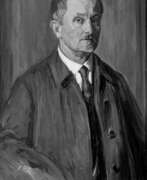

Wilhelm Laage was a German painter, graphic artist, engraver and woodcarver.
Laage attended the Hamburg School of Crafts and the Art Academy in Karlsruhe, and in 1896 began working with woodcuts and lithography. In 1904 Lage took part in exhibitions in Vienna and Dresden, in 1914 he was awarded the Villa Romana Prize, the Honorary Prize of the City of Leipzig and the State Medal at the International Graphic Exhibition in Leipzig. Wilhelm Laage was a member of the German Artists' Association.


Jean Lébédeff, birth name Ivan Konstantinovich Lebedev was a French painter and graphic illustrator of Russian origin. He was an activist of the anarchist movement. Representative of the Russian creative and political emigration in France. Author of drawings and engravings depicting literary heroes from the works of Pushkin, Gorky, Kuprin and Tolstoy.


Mel Lindquist, born Melvin Benjamin Lindquist, is an American engineer who pioneered the American Studio Wood Turning movement.
The founder of the studio wood turning movement, Mel Lindquist applied his basic machine tool techniques and engineering expertise to pioneering gouging methods called "blind boring" or "blind turning" that are widely used today.




Karl Opfermann, a German sculptor and graphic artist born in 1891 in Rødding (now Denmark), carved a niche for himself in the realms of art and culture. His initial training as an ornament creator led him to the influential circles of Hamburg and Berlin, where he honed his artistic skills under the guidance of Heinz Wedding, Fritz Heit, and Richard Luksch. Opfermann's artistic journey was deeply intertwined with notable groups like the "Hamburgische Sezession" and the "Novembergruppe" in Berlin, where he played a pivotal role in shaping the local sculptural landscape from 1919 to 1933.
Tragically, Karl Opfermann's works became a target during the "Entartete Kunst" (Degenerate Art) action in 1937 by the Nazis, leading to their removal and destruction from German museums. A significant portion of his oeuvre was further lost in a bombing in 1943, which destroyed his studio in Hamburg. Despite these challenges, Opfermann's legacy persists, with efforts to reconstruct his life and works focusing on the years before 1943, the period before the destruction wrought by the Nazis and World War II.
Karl Opfermann's artistic expression was rooted in German Expressionism, a movement born out of resistance and reaction, emphasizing emotion and individual experience. His works, spanning various mediums including wood, stone, and ceramics, reflect a profound emotional depth and a unique exploration of human form and expression.
For collectors and experts in art and antiques, Karl Opfermann's work offers a compelling glimpse into the turbulent yet artistically rich period of early 20th-century Germany. His sculptures and graphic art, held in various collections throughout Germany, including Hamburg and Flensburg, stand as a testament to his enduring impact on German Expressionism.
To delve deeper into the world of Karl Opfermann and stay informed about new sales or auction events related to his work, consider signing up for updates. This subscription is an opportunity to explore and appreciate the profound legacy of this influential artist.


Elijah Pierce was a 20th-century wood carver. Pierce was the youngest in his family born from a former slave on a farm in Baldwyn. He began carving at a young age using a pocket knife. He first started carving animals because of his prior life of growing up on a farm. Pierce was honored with the National Heritage Fellowship for his art and influence in the woodcarving community in 1982.


Lucien Pissarro was a French painter, graphic artist and woodcutter, representative of Pointillism. Son of Camille Pissarro. Since 1890, he lived and worked in England.
Lucien Pissarro initially studied painting under his father. He later developed his own artistic style influenced by the neo-impressionist techniques of Georges Seurat and Paul Signac. Like other Neo-Impressionist painters, Pissarro used broken strokes and divisionism techniques to create light and vivid effects.
The subjects of Pissarro's paintings often included landscapes, rural scenes and coastal vistas, reflecting his love of nature and the countryside. He was particularly fond of capturing the effects of light and atmosphere in his paintings, using a subtle and harmonious colour palette.


Walter Tanck was a German landscape painter, engraver and woodcarver. He studied painting with Franz Nölken in Hamburg.
In 1937, as part of the Nazi "Degenerate Art" campaign, his graphic portfolio "Don Quixote" (15 etchings and a lithograph on the title page) from the Dusseldorf Art Collection and his panel "Nude Woman" were confiscated and destroyed.


Clifford Possum Tjapaltjarri was an Australian painter, considered to be one of the most collected and renowned Australian Aboriginal artists. His paintings are held in galleries and collections in Australia and elsewhere, including the Art Gallery of New South Wales, the National Gallery of Australia, the Kelton Foundation and the Royal Collection.
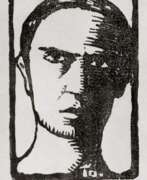

Tobeen, a pseudonym for the French artist Félix Bonnet, was a notable figure in the art world. Tobeen's work, particularly influenced by Cubism, stands out for its unique integration of Basque cultural themes, despite his Bordeaux roots.
His artistic venture in Paris connected him with prominent figures like Pablo Picasso, Georges Braque, and the Duchamp brothers. Notably, in 1912, Tobeen's works were showcased at the Salon de la Section d'Or, aligning him with the avant-garde movements of the time. After 1920, Tobeen opted for a quieter life in Saint-Valery-sur-Somme, where his works continued to reflect his Parisian experiences and his deep appreciation for human life's poetic aspects.
Tobeen's legacy extends across various museums globally, with his works housed in institutions like the Centraal Museum in Utrecht, the Kröller-Müller Museum in Otterlo, and the Musée basque et de l'histoire de Bayonne, among others. His art offers a captivating glimpse into early 20th-century European modernism, marked by a distinctive blend of geometric abstraction and regional inspiration.
For enthusiasts of art and antiques, Tobeen's oeuvre represents an intriguing chapter in the history of Cubism, offering a unique perspective shaped by his Basque Country experiences and Parisian artistic connections. Collectors and experts can delve into Tobeen's world, discovering how his works bridge cultural narratives and avant-garde aesthetics.
To stay updated on Tobeen's art and opportunities to view or acquire his works, consider signing up for updates on exhibitions and auction events featuring this remarkable artist.


Edgard Tytgat is a Belgian painter, engraver, illustrator, draftsman, etcher, watercolourist and wood engraver. As an engraver and xylographer, he illustrated numerous works. His painting, in a style inspired by Post-Impressionism, is often described as naive painting, with scenes of daily life, interiors, fairs, lovers, but not devoid of sweet poetry. From 1950, he approached the representation of mythological legends sometimes bathed in a certain eroticism. Edgard Tytgat has participated in numerous exhibitions, both personal and collective, in Belgium and abroad.


Félix Vallotton, a Swiss-born French graphic artist and painter, is recognized for his distinctive woodcuts and paintings of nudes and interiors. Vallotton's journey into art began in Paris, where he attended the Académie Julian, fostering a unique style that broke from traditional norms. His early works, characterized by extreme realism, were showcased at the Salon des Artistes Français and the Paris Universal Exposition of 1889. This period also marked Vallotton's encounter with Japanese prints, notably those by Hokusai, profoundly influencing his artistic direction.
In 1892, Vallotton joined Les Nabis, a group of avant-garde artists including Pierre Bonnard, Maurice Denis, and Édouard Vuillard, which led to a significant evolution in his style. His paintings from this era, such as "Bathers on a Summer Evening" and "Moonlight," exhibited at the Kunsthaus Zürich and the Musée d'Orsay respectively, reveal a departure from realism towards a more symbolic and abstract representation. The works from this period are characterized by flat areas of color, hard edges, and simplified details, mirroring the style he developed in his woodcuts.
Vallotton's woodcuts, like "Intimités" (Intimacies), a series published in 1898, showcased his mastery in capturing the nuances of human relationships, particularly the tensions between men and women. His graphic art, which included depictions of domestic scenes, bathing women, and street crowds, was not just celebrated in Europe but also influenced artists like Edvard Munch, Aubrey Beardsley, and Ernst Ludwig Kirchner.
Towards the end of his career, Vallotton continued to innovate, combining elements of realism and abstraction, evident in paintings like "La Malade" (The Sick Girl) and "Clair de lune" (Moonlight). His works remain a testament to his ability to merge technical precision with a poignant exploration of human emotions and societal themes.
For art collectors and experts, Vallotton's body of work offers a rich and diverse exploration of early 20th-century art movements, especially his role in the development of modern woodcut techniques and his contribution to the Nabis movement. His works are a study in the fusion of realism and symbolism, marked by a distinctive style that makes his art enduringly relevant and compelling.
For those interested in discovering more about Félix Vallotton and staying updated on related product sales and auction events, signing up for updates is a great opportunity. This subscription will exclusively alert you to new sales and events pertaining to Vallotton's works, ensuring you remain informed in the dynamic world of art and antiques.


Paloma Varga Weisz is a German sculptor and painter, the daughter of the Hungarian artist Ferenc Farga, who lives and works in Düsseldorf.
She is primarily known for her wood-carved sculptures and installations. In 2012, six of Weisz's drawings were purchased and exhibited at the Museum of Modern Art in New York.


Peter Zaumseil, born in 1955 in Greiz, Germany, is a German artist known for his work with woodcuts, painting, and various printmaking techniques. He has had a significant influence on the contemporary art scene in Germany, producing original artworks and artist books. His work often explores the natural world and landscapes, reflecting his deep connection with the Vogtland region.
Zaumseil's portfolio includes a variety of art forms, from colorful woodcuts to expressive paintings and sculptures. His talent for creating vibrant and detailed woodcuts is demonstrated in his original art book, "Wasser ist Leben – die Weiße Elster von der Quelle bis zur Mündung," which contains 50 woodcuts depicting the journey of the Weiße Elster river.
His works have gained recognition in the art market, with pieces sold at various auctions. His auctioned works range from expressive coffeehouse interiors to unique paper cuts, showcasing his versatility and skill in different mediums. Many of his pieces, including "Im Dreieck II," "Teuflisch guter Wein," and "Schwarze Figur 1," highlight his ability to create intricate designs with a striking use of color.
Collectors and art experts can explore Zaumseil's work at art galleries and exhibitions across Germany, as well as through online platforms specializing in contemporary art. If you're interested in staying updated on new releases and auction events related to Peter Zaumseil, consider signing up for updates to receive information on new product sales and art-related activities.


Uta Zaumseil is a renowned German artist known for her woodcuts, linocuts, and collage art. Her unique approach to art involves synthesizing traditional techniques with photography, creating a distinct and expressive style. She has been recognized for her bold use of color and intricate motifs, leading to a vivid and engaging imagery.
Zaumseil's works have been exhibited in various galleries and museums, with notable solo exhibitions at the Kunsthalle Weimar, Hans-Thoma-Museum, and Galerie Kuchling in Berlin. She has also received several prestigious awards, including the Ruth-Huhn-Kunstpreis and the Künstlerförderung der IG Metall.
Collectors and experts in art and antiques can find Uta Zaumseil's artwork at various exhibitions and auctions. She has garnered attention for her detailed prints, often created using the lost plate technique, where sections of the printing surface are gradually removed to create intricate multi-layered designs. Her innovative approach and detailed craftsmanship have earned her a respected position in the art world.
If you are interested in learning more about Uta Zaumseil's work or attending future exhibitions, consider signing up for updates to stay informed about new products and auction events.




